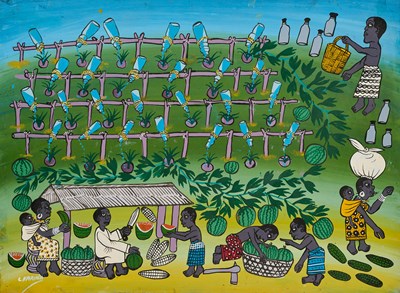1st May, 2024 12:00
Modern and Contemporary African and Middle Eastern Art
1
MOHAMED CHARINDA (TANZANIAN 1947-2021)
UNTITLED
signed CHARINDA lower left
oil on canvas
signed CHARINDA lower left
oil on canvas
54.5 x 75.5cm; 21 1/2 x 29 3/4in
(unframed)
Property from a Private Collection, London
Provenance
Acquired from the artist by the present owner
Charinda was born in Tanzania in the village of Nakupanya, Tunduru District, Ruvuma Region. In 1972, he moved to Dar es Salaam and from 1974 trained under the artist Hashim Mruta. He is one of the earliest and most recognised followers of the Tingatinga school of art, founded by Edward Saidi Tingatinga (1932-72).
(unframed)
Property from a Private Collection, London
Provenance
Acquired from the artist by the present owner
Charinda was born in Tanzania in the village of Nakupanya, Tunduru District, Ruvuma Region. In 1972, he moved to Dar es Salaam and from 1974 trained under the artist Hashim Mruta. He is one of the earliest and most recognised followers of the Tingatinga school of art, founded by Edward Saidi Tingatinga (1932-72).
Artists of the Tingatinga school commonly depict idealised nature and the people and culture of Tanzania in a colourful, naïve style. Contrary to his fellow apprentices, Charinda's subject matter focuses on Tanzanian history, often portraying warfare, the East African slave trade, folk tales and scenes of rural life. He was one of the first artists to introduce different media and techniques to the practice. For instance, he used canvas instead of masonite panels, which allowed tourists to carry them home easily, making the art more marketable.
As a member of the Tingatinga Arts Cooperative Society, Charinda's work has been exhibited in Switzerland and Paris at the Institut du Monde Arabe in Tresors de L'Islam en Afrique: De Tombouctou à Zanzibar. His work can also be found in the Brtish Museum and Indigo Arts in Philadelphia, USA.
As a member of the Tingatinga Arts Cooperative Society, Charinda's work has been exhibited in Switzerland and Paris at the Institut du Monde Arabe in Tresors de L'Islam en Afrique: De Tombouctou à Zanzibar. His work can also be found in the Brtish Museum and Indigo Arts in Philadelphia, USA.
Sold for £300
UNTITLED
signed CHARINDA lower left
oil on canvas
signed CHARINDA lower left
oil on canvas
54.5 x 75.5cm; 21 1/2 x 29 3/4in
(unframed)
Property from a Private Collection, London
Provenance
Acquired from the artist by the present owner
Charinda was born in Tanzania in the village of Nakupanya, Tunduru District, Ruvuma Region. In 1972, he moved to Dar es Salaam and from 1974 trained under the artist Hashim Mruta. He is one of the earliest and most recognised followers of the Tingatinga school of art, founded by Edward Saidi Tingatinga (1932-72).
(unframed)
Property from a Private Collection, London
Provenance
Acquired from the artist by the present owner
Charinda was born in Tanzania in the village of Nakupanya, Tunduru District, Ruvuma Region. In 1972, he moved to Dar es Salaam and from 1974 trained under the artist Hashim Mruta. He is one of the earliest and most recognised followers of the Tingatinga school of art, founded by Edward Saidi Tingatinga (1932-72).
Artists of the Tingatinga school commonly depict idealised nature and the people and culture of Tanzania in a colourful, naïve style. Contrary to his fellow apprentices, Charinda's subject matter focuses on Tanzanian history, often portraying warfare, the East African slave trade, folk tales and scenes of rural life. He was one of the first artists to introduce different media and techniques to the practice. For instance, he used canvas instead of masonite panels, which allowed tourists to carry them home easily, making the art more marketable.
As a member of the Tingatinga Arts Cooperative Society, Charinda's work has been exhibited in Switzerland and Paris at the Institut du Monde Arabe in Tresors de L'Islam en Afrique: De Tombouctou à Zanzibar. His work can also be found in the Brtish Museum and Indigo Arts in Philadelphia, USA.
As a member of the Tingatinga Arts Cooperative Society, Charinda's work has been exhibited in Switzerland and Paris at the Institut du Monde Arabe in Tresors de L'Islam en Afrique: De Tombouctou à Zanzibar. His work can also be found in the Brtish Museum and Indigo Arts in Philadelphia, USA.
Auction: Modern and Contemporary African and Middle Eastern Art, 1st May, 2024
Viewing
PUBLIC EXHIBITION
Sunday 28th April 12:00pm - 4:00pm
Monday 29th April 10:00am - 8:00pm
Tuesday 30th April 10:00am - 5:00pm



